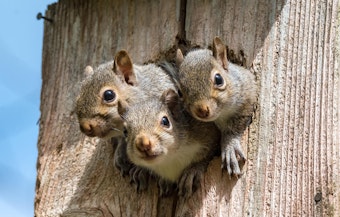 Be Inspired Blog - Arizona
Be Inspired Blog - Arizona

Defend Your Garden with Ease: 10 Practical Tips to Combat Common Animals and Pests
Planting and growing your own vegetables can be rewarding, but learning to protect your garden from pests and animals can involve a lot of trial and error – especially if you aren’t sure which common garden pest is helping themselves to a private salad bar. We've found 10 easy ways to protect your garden from the experts at Country Living magazine.
Protect Your Garden from Pests & Animals In A Few Easy Steps
Step 1: Identify The Culprit

Choosing the right kind of management method, such as how tall a fence you might need, means figuring out who’s eating what. Look for telltale signs:
- Birds peck holes in fruit or steal it before you even know it’s ripe
- Deer may leave tracks in the soil and make clean snips on herbaceous plants or tear woody plants (for those of you who live up north)
- Javelinas can cause plant damage to your garden (partially eaten plants, missing foliage), disturb soil, and leave hoof-like tracks, scat (droppings), and odors behind
- Rabbits make sharp cuts on herbaceous and woody plants and may leave pellet droppings
- Squirrels will split shells or husks of nuts, and dig up flower bulbs
Step 2: Fence It
Fencing is the most effective way to protect your garden from pests and keep unwanted visitors out. A fence that’s two to three feet tall will work for most rabbits, although persistent ones may try to burrow underneath. To deter them, extend the fence about a foot underground.
Chicken wire, hardware cloth or rabbit fencing are the least expensive alternatives for small mammals. A fence that’s at least six to eight feet tall will work for most deer, and plastic bird netting can be placed over small edible bushes like berries before they ripen.

Step 3: Choose Less Tasty Plants
If they’re hungry enough, animals will eat anything. But there are certain kinds of plants that are less appealing than others – especially plants that are highly aromatic, fuzzy or have prickles. Take a look around your neighborhood to see what’s fared well and talk to your local nursery (like our gardening experts here at SummerWinds) for recommendations.
Step 4: Protect New Plants
If your seeds are starting to sprout, or maybe you’ve just brought home some starts from the nursery, animals and garden pests will be attracted to the tender new growth. The plant’s small size and new lease on life will leave them much less able to bounce back from grazing damage.
Protect your garden by installing a fence or using trunk wraps to protect new plants and shrubs, and a light net covering over planter boxes.

Step 5: Garden In Pots And Raised Beds
Sometimes you can protect your garden from pests and prevent animals from nibbling by elevating your pots or planting in raised beds. A raised bed two feet or taller will limit rabbit damage, especially if you add a short fence on top. Pots can be mounted on railings, or try planting greens in window boxes – and out of reach of hungry bunnies and deer.
Step 6: Don’t Be Too Tidy
If you live in a less urban area, let the shrubs and grasses around the edge of your yard go a little wild. If there are other opportunities for food around you, your garden will present less of an attractive target. Animals will also be less likely to come out into the middle of your yard, where they will be exposed to predators, if there is a food source nearby that doubles as shelter.

Step 7: Contain Your Compost
Open compost piles attract all kinds of creatures that then discover the other delicacies in your backyard. Protect your garden from pests by using a self-contained compost with a lid to keep dumpster divers away. If you feed your pets outdoors, be sure to bring their bowls inside after meals so you won’t attract javelinas, skunks, opossums and raccoons. If you keep bird seed or other food sources outside, secure them in a sealed bucket or chew-proof container.
Step 8: Scare Them Away
Metallic streamers, bird tape or an old-fashioned scarecrow may keep birds away, but require being moved around the yard regularly so they don’t get used to them. Motion-activated sprinklers or lights are another possibility to scare away mammals.
Step 9: Try Repellants
Odor repellants, like granulars or coyote urine, attempt to keep the animal away from an area with a bad smell. Taste repellents are sprayed on vulnerable plants and cause an animal that ingests them to feel sick. It’s important to note that they won’t cause long-term damage, but they can help train pests to stay away from a specific area.
Keep in Mind: These products have to be used year-round and must be reapplied after rain. In addition, animals are known to get used to the tast and simply eat the plants anyway. Therefore, we recommend using this method in conjunction with other deterrants.

Step 10: Do A Reality Check
In any given year, there are a number of factors that affect how much damage animals might impact your garden. There will be good years and bad years, and realize that what you’re doing in your yard benefits the local wildlife too – even if you didn’t get to enjoy that heirloom tomato you planted, there’s always next season.

